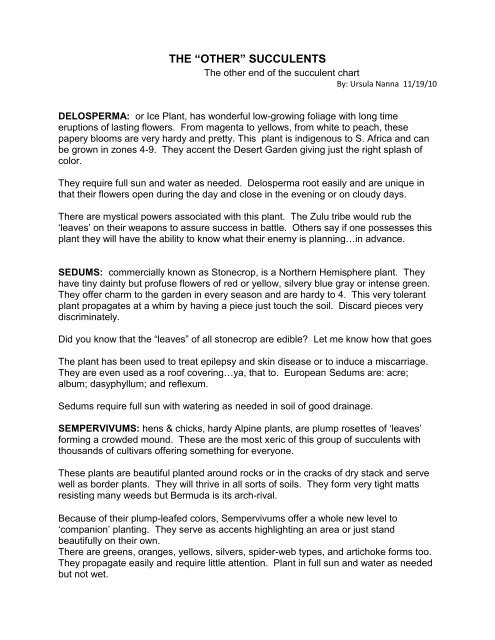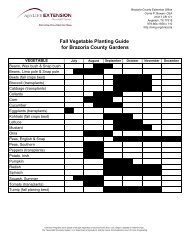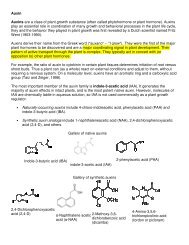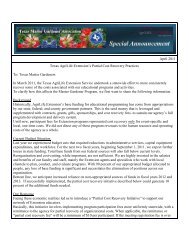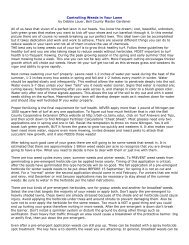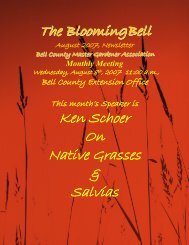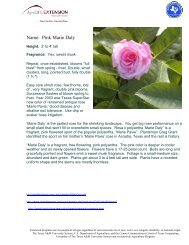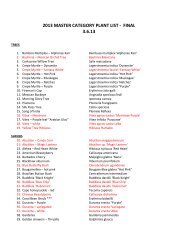THE “OTHER” SUCCULENTS
THE “OTHER” SUCCULENTS
THE “OTHER” SUCCULENTS
You also want an ePaper? Increase the reach of your titles
YUMPU automatically turns print PDFs into web optimized ePapers that Google loves.
<strong>THE</strong> “O<strong>THE</strong>R” <strong>SUCCULENTS</strong>The other end of the succulent chartBy: Ursula Nanna 11/19/10DELOSPERMA: or Ice Plant, has wonderful low-growing foliage with long timeeruptions of lasting flowers. From magenta to yellows, from white to peach, thesepapery blooms are very hardy and pretty. This plant is indigenous to S. Africa and canbe grown in zones 4-9. They accent the Desert Garden giving just the right splash ofcolor.They require full sun and water as needed. Delosperma root easily and are unique inthat their flowers open during the day and close in the evening or on cloudy days.There are mystical powers associated with this plant. The Zulu tribe would rub the‘leaves’ on their weapons to assure success in battle. Others say if one possesses thisplant they will have the ability to know what their enemy is planning…in advance.SEDUMS: commercially known as Stonecrop, is a Northern Hemisphere plant. Theyhave tiny dainty but profuse flowers of red or yellow, silvery blue gray or intense green.They offer charm to the garden in every season and are hardy to 4. This very tolerantplant propagates at a whim by having a piece just touch the soil. Discard pieces verydiscriminately.Did you know that the “leaves” of all stonecrop are edible? Let me know how that goesThe plant has been used to treat epilepsy and skin disease or to induce a miscarriage.They are even used as a roof covering…ya, that to. European Sedums are: acre;album; dasyphyllum; and reflexum.Sedums require full sun with watering as needed in soil of good drainage.SEMPERVIVUMS: hens & chicks, hardy Alpine plants, are plump rosettes of ‘leaves’forming a crowded mound. These are the most xeric of this group of succulents withthousands of cultivars offering something for everyone.These plants are beautiful planted around rocks or in the cracks of dry stack and servewell as border plants. They will thrive in all sorts of soils. They form very tight mattsresisting many weeds but Bermuda is its arch-rival.Because of their plump-leafed colors, Sempervivums offer a whole new level to‘companion’ planting. They serve as accents highlighting an area or just standbeautifully on their own.There are greens, oranges, yellows, silvers, spider-web types, and artichoke forms too.They propagate easily and require little attention. Plant in full sun and water as neededbut not wet.
JOVIBARBAS: is a small genus of 3 species: J. globifera; J. heuffelii; and J. hirtahailing from the Balkins to the Southern Alps. They are closely related toSempervivums. Jovibarbas can be grown in as little as 4 hours of sun. They(globifera), exhibit an interesting growth habit and because of this habit, some theys arecalled ‘rollers’. The new baby ‘chicks’ grow mounded on the mother rosette and whenmature, roll off to begin a family of their own. This makes Jovibarba different fromSempervivums because Semps’ rosettes form under the mother and their flowers areout and down rather than up. Also, they do not produce offsets on stolons but from verytight clusters.These plants are ‘monocarpic’ or once blooming, because after the bloom, the rosettedies.Jovis make excellent container plants.Jovibarbas are hardy to Zone 3. As with all succulents, water discriminately…asneeded, in full sun. Always plant is a well draining soil.ROSULARIAS and OROSTACHYS: other closely related plants to Semps and Jovis.Rosularias are not hardy in our area. They produce beautiful bell-shaped blooms andthey hail from Turkey and the Himalayas. They require whatever is in this area soil togrow and prosper.Orostachys are rare and seldom found in our area except in nurseries specializing inthis plant.


